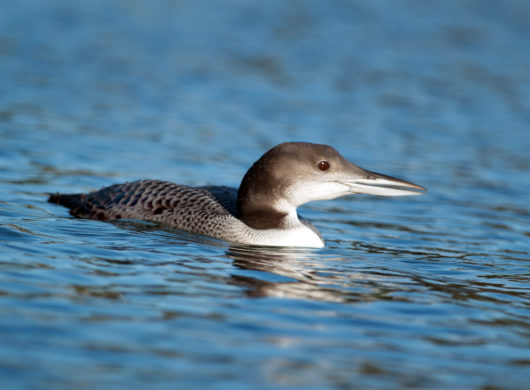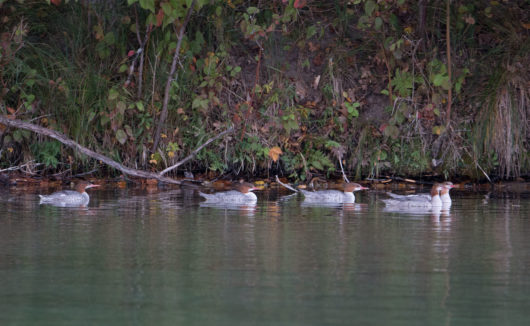These female Mallards moved off from a group of about 50 female Mallards that have been sunning themselves on the skinny beach near the cut-through at the island in the lower lake. The big group is making a bit of Long Lake history. A group like this hasn’t been seen at least in the dozen years we’ve been on the lake. The group sits, splashes about, dabbles around, and just generally does all things duck all day long. Very weird. It seems like they should have someplace to go by now.
These three seemed to be practicing their yoga asanas. When the females are in the water that cobalt blue patch isn’t seen. Nice of this individual to stretch enough to give us a good view.
Mallards are very vocal ducks, especially the females. In fact, they are one of very few ducks that actually quack.
The adult Loons left the lake in September, early September we believe. And we’ve decided not to worry, but there seems to be only one adolescent loon left on the lake. The sibs hung out together, for the most part, in the first weeks after mom and pop flew south. But now we see only one. One of the chicks was a bit smaller and we’re hopeful this one is just playing it smart, bulking up for the long flight south.
On October 14th, this adolescent approached our kayaks within about 15 feet. Steve took his photo. We paddled into Ghost Bay and this guy paddled in too, calmly floating near us, diving, and then resurfacing close by. We’ve not heard any vocalization. I guess when there’s no one to talk to, a loon just keeps their own counsel.
We will worry if this guy isn’t headed south in the next 2-3 weeks.
Common Mergansers are back on the lake. As with the Mallards, we are seeing only females. We’ve been seeing them in small groups swimming in the shallows. They dive and come up with mostly major sloppy stuff spilling out of their bills. Or they come up empty. For no reason we can discern, they are prone to episodes of water scooting.They flap their wings, flap their feet, rise up just a few inches off the water, and scoot ten or fifteen feet. They are the slapstick comedians of the waterfowl world.
This trio of females was a real surprise. They are Surf Scoters. They aren’t rare. But we’ve never seen them on Long Lake. From a distance, we thought they were American Black Ducks. But then those two white patches on the sides of their heads caught our attention. And then we noticed their spectacular large bills. A Surf Scoter’s scientific name is Melanitta Perspicullata, which basically means Black (duck) Spectacular. Someday I hope to meet a male Surf Scoter. His bill is even more bulbous than the female’s. And, instead of dull gray, his bill is white, yellow, and red, set off by a white forehead outlined in black. Now that’s spectacular!




